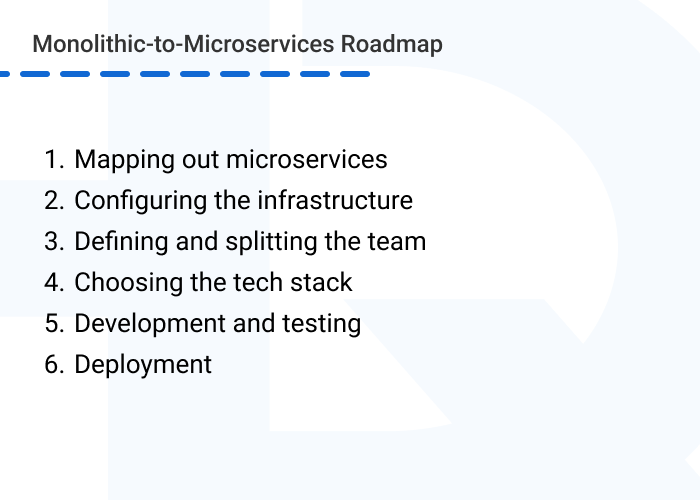Monolithic-to-Microservices Roadmap
Factors to Consider Before Monolithic-to-Microservices Migration
Freezing new features development
Choosing an experienced migration team
When a project with a monolithic architecture becomes too big, bulky, and challenging to maintain and update, you can probably start looking towards a more modern and convenient architecture, such as microservices.
If, after debating monolithic vs. microservices, you do decide to migrate, there are several critical factors to consider. Based on my experience working at HQSoftware on several migration projects, I’m going to highlight some key factors to consider before migrating that will help make the process as smooth as possible.
Monolithic-to-Microservices Roadmap
Factors to Consider Before Monolithic-to-Microservices Migration
Freezing new features development
Choosing an experienced migration team
Migrating to microservices is more than a simple system upgrade. It’s a complex and long-term process that can entail significant changes, such as team restructuring, selecting new systems, and more. That’s why you should have a clear roadmap that will help you embrace a variety of changes smoothly.
While I’ve worked on several projects, each requiring a customized roadmap to meet unique business needs, I can outline a general microservices roadmap:
Firstly, you and your team should determine which microservices the new architecture will include. Typically, microservices are divided up based on functionality, with each responsible for a particular task.
To perform the division correctly and avoid redundant or partially duplicated microservices, you should thoroughly investigate components of the monolithic app that may have similar functionality and address this duplication.
In my experience, any monolithic application can be split. However, the quality and accuracy of this process depend on the skills and experience of your team.
Engage experienced DevOps engineers to define databases, communication protocols, clouds, and data synchronization methods and then set up the environment.
Typically, particular developers are responsible for specific microservices. However, teams can also be cross-service, i.e. work with numerous services if required.
Another approach is to organize specialists based on complex processes that can cover many microservices. For example, you may have one team responsible for infrastructure, a separate team for data management, etc. This is the approach we took on one of our projects for a cloud-based LMS development.
Upgrade your outdated system with a modern microservices arcitecture!HQSoftware has a team of skilled professionals ready to tackle the project. Let’s talk!
Anna Halias
Business Development Manager
One of the advantages of microservices is the ability to choose the most appropriate tech stack for each functionality. So, collaborate with tech leads to identify the technologies and frameworks that will ensure reliable and efficient performance from each component and the entire application.
Once you’ve determined which teams will work with which technologies to build microservices, your team should gather a list of all monolithic app features and create sprints and assessments for them.
Then, you’re ready to start the migration.
I suggest starting development with an MVP. Choose one or several of the most important microservices as a pilot project to test the chosen architecture and tools. Then gradually add and extend them.
Comprehensive testing is also a must-have for quality code refactoring. Therefore, be sure the team will perform unit, integration, and acceptance testing.
Deploy microservices gradually, while ensuring backward compatibility with the monolithic application. This approach minimizes disruptions during the transition.

While this monolithic-to-microservices roadmap already outlines some factors to pay special attention to, you should keep in mind some additional crucial considerations before microservices migration, to avoid common challenges.
Without delving into the technical aspects of the migration from monolithic to microservices, I suggest considering the following points:
As previously mentioned, a clear migration from monolithic to microservices roadmap is the first step in ensuring a successful transition. So, pay special attention to this preliminary stage, as it’s easy to overlook critical aspects, leading to confusion and errors.
Along with reasonable resource allocation, risk mitigation, and workload distribution, a precise plan ensures transparency throughout the migration process, not only for you and the development team but also for the business owners.
Additionally, plan for contingencies and potential setbacks. Consider what steps to take if issues arise during the migration and how to roll back to the previous architecture if necessary.
In my observation, one of the main reasons projects collapse is continuing system updates and enhancements during the migration.
If a business constantly demands system changes, such as adding new features or updating old ones, the team will face double the work. First, they need to spend resources on implementing these improvements within the monolith and then move them to microservices. This leads to increased complexity in the monolithic architecture, prolonging the migration and accumulating technical debt.
As a result, the team may lose a lot of time and resources, ending up with a huge backlog of unresolved tasks and a non-working microservices architecture.
Conduct a comprehensive assessment of your existing monolithic system to identify areas requiring improvement or containing outdated functionality. The migration process is a great opportunity to rebuild inefficient and obsolete processes using modern technologies and approaches. Relatively new features can be adapted to microservices with minimal changes.
Also, keep in mind that besides reworking pre-planned functionality, developers may discover additional code weaknesses during the migration. This may lead to further adjustments and an extended development timeline.
Despite having an “ideal” theoretical microservices migration roadmap, very often it’s quite difficult to fully apply it in practice, as each project is unique and requires its own approach. To identify the most appropriate one, you need a skilled migration team. Here’s what my colleague has to say about that.
Jegor Alexeichuk
Mobile Development Team Lead
at HQSoftwareSuccessful migration is more than just a technical task. Of course, it will become primarily technical, requiring a gradual and careful process. But above all, it’s important to choose the right team. You need people with the right patterns in their minds, and technical intuition.
The rest is a matter of techniques and developers’ expertise. I think this is an important advantage of our technical team at HQSoftware, as we have many qualified developers who have hands-on experience in migration and know the main pitfalls and strategies to overcome them.
How much time do you need for the transition? Let’s hear from the head of PMO at HQSoftware.
Andrey Kazakevich
Head of Production
at HQSoftwareThe transition from monolith to microservices is not a spotty task, but a journey into the unknown that can take a long time. There’s no set minimum timeframe, as it depends on the project’s complexity and requirements. It could take a year, or it might extend to a couple of years.
So that you are not intimidated by such timelines, keep in mind that your monolithic app will continue to work during the migration. While it’s recommended to stop expanding and adding new features, your solution will remain operational until the full migration to microservices is complete.

For a seamless migration to microservices, you need 3 key components: a well-defined microservices roadmap, an experienced team, and enough time.
At HQSoftware, we can take care of one of these components and provide you with a skilled development team. Our arsenal includes experienced DevOps, tech leads, developers, and QA engineers who will not only perform technical tasks but also help you build a comprehensive monolithic-to-microservices roadmap. Contact us to learn more about our migration to microservices services.

Lead Software Engineer
An experienced developer with a passion for IoT. Having participated in more than 20 Internet of Things projects, shares tips and tricks on connected software development.
We are open to seeing your business needs and determining the best solution. Complete this form, and receive a free personalized proposal from your dedicated manager.

Sergei Vardomatski
Founder